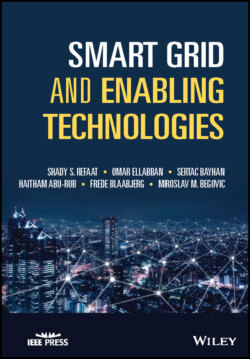Читать книгу Smart Grid and Enabling Technologies - Frede Blaabjerg - Страница 27
1.5.1 Distributed Generation
ОглавлениеDER are defined as small‐scale decentralized power generation sites as shown in Figure 1.8 [20]. The systems with DER are modular, and flexible usually located in the vicinity of the load. DER systems utilize renewable energy sources such as small hydro, biomass, biogas, solar, wind, and geothermal. Such systems can be controlled and coordinated within an SG. Using the distributed generation makes the grid active of bidirectional flow of power [21, 22].
Figure 1.6 SG components.
Figure 1.7 Main key technology areas of smart grid.
Figure 1.8 Distributed energy resources paradigm in smart grid. Ref [20]. Reproduced with permission from IEEE.
DERs can offer potential benefits to the electric grid such as improving energy efficiency, enhancing energy security, and ensuring faster recovery of electricity services. DERs may serve in a single structure connected to an isolated grid, become part of a microgrid, or be connected to the distribution system. Distributed generation can support the delivery of clean, reliable power which supports reducing electricity losses over transmission and distribution lines. The impact of the DERs depends on different factors [23]; such as:
Size and penetration level of the DGs.
Type of the DGs, unit ratings, unit impedance, and used transformers used, etc.
Mode of operation and the interconnection methods with the grid or with the local loads.
On other side, the penetration of DGs increases the complexity of power grids and presents significant stability and control challenges, which may cause greater voltage and frequency deviations and coordinating problems. To overcome these challenges, a coordinated control and managing system must be used to provide the continuity of service, while still meeting customer demands and ensuring the vulnerability of the power system.
